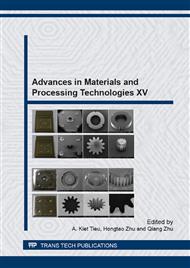p.461
p.466
p.471
p.478
p.488
p.496
p.503
p.512
p.518
Measuring the Mechanical Properties of Ground Ophthalmic Polymer Surfaces Using Nanoindentation
Abstract:
This work is motivated by the need to efficiently machine the edges of ophthalmic polymer lenses for mounting in spectacle or instrument frames. The polymer materials used are required to have suitable optical characteristics such high refractive index and Abbe number, combined with low density and high scratch and impact resistance. Edge surface finish is an important aesthetic consideration; its quality is governed by the material removal operation and the physical properties of the material being processed. The wear behaviour of polymer materials is not as straightforward as for other materials due to their molecular and structural complexity, not to mention their time-dependent properties. Four commercial ophthalmic polymers have been studied in this work using nanoindentation techniques which are evaluated as tools for probing surface mechanical properties in order to better understand the grinding response of polymer materials.
Info:
Periodical:
Pages:
488-495
Citation:
Online since:
November 2013
Authors:
Keywords:
Price:
Сopyright:
© 2014 Trans Tech Publications Ltd. All Rights Reserved
Share:
Citation:


